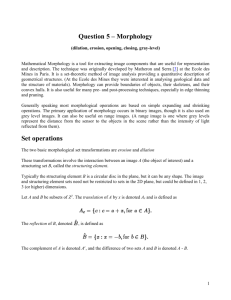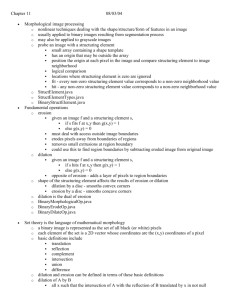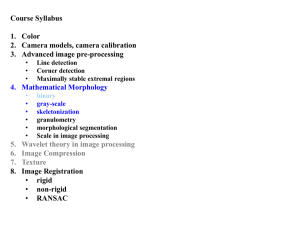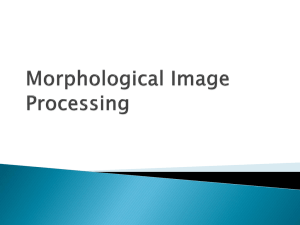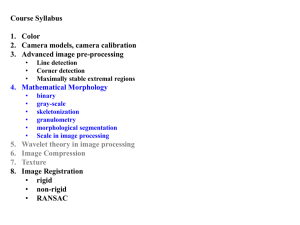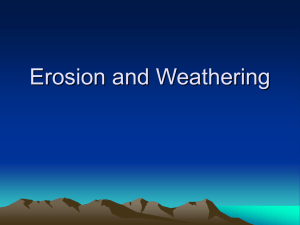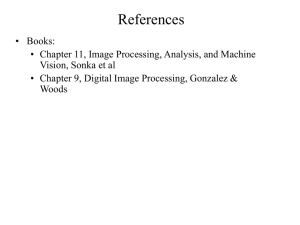Chapter 9: Morphological Image Processing
advertisement
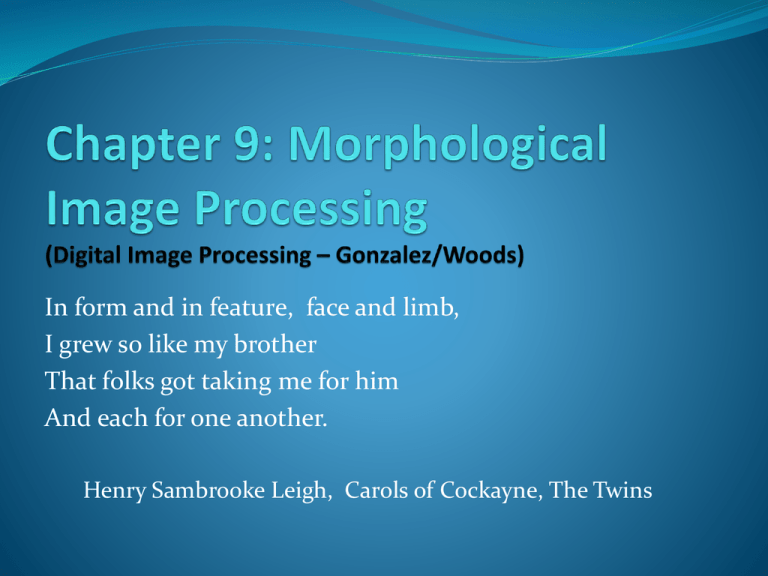
In form and in feature, face and limb,
I grew so like my brother
That folks got taking me for him
And each for one another.
Henry Sambrooke Leigh, Carols of Cockayne, The Twins
Preview
“Morphology “ – a branch in biology that deals with the form
and structure of animals and plants.
“Mathematical Morphology” – as a tool for extracting
image components, that are useful in the representation and
description of region shape.
The language of mathematical morphology is – Set theory.
Unified and powerful approach to numerous image
processing problems.
In binary images , the set elements are members of the
2-D
integer space – Z . where each element (x,y) is a coordinate of
a black (or white) pixel in the image.
9.1 Basic Concepts in Set Theory
Subset
Union
Intersection
disjoint / mutually exclusive
Complement
Difference
Reflection
Translation
Logic Operations Involving Binary
Pixels and Images
The principal logic operations used in image processing
are: AND, OR, NOT (COMPLEMENT).
These operations are functionally complete.
Logic operations are preformed on a pixel by pixel basis
between corresponding pixels (bitwise).
Other important logic operations :
XOR (exclusive OR), NAND (NOT-AND)
Logic operations are just a private case for a binary set
operations, such : AND – Intersection , OR – Union,
NOT-Complement.
9.2.1 Dilation
Dilation is used for expanding an element A by using structuring
element B
Dilation of A by B and is defined by the following equation:
This equation is based 0n obtaining the reflection 0f B
about its origin and shifting this reflection by z.
The dilation of A by B is the set of all displacements z,
such that and A overlap by at least one element. Based
On this interpretation the equation of (9.2-1) can be
rewritten as:
9.2.1 Dilation – Example 1
9.2.1 Dilation – Example 2
9.2.1 Dilation – A More interesting
Example
9.2.2 Erosion
Erosion is used for shrinking of element A by using
element B
Erosion for Sets A and B in Z2, is defined by the
following equation:
This equation indicates that the erosion of A by B is
the set of all points z such that B, translated by z, is
combined in A.
9.2.2 Erosion – Example 1
9.2.2 Erosion – Example 2
Duality between dilation and
erosion
Dilation and erosion are duals of each other with
respect to set complementation and reflection. That is,
One of the simplest uses of erosion is for eliminating
irrelevant details (in terms of size) from a binary
image.
Erosion and Dilation summary
9.3 Opening And Closing
Opening – smoothes contours , eliminates protrusions
Closing – smoothes sections of contours, fuses narrow
breaks and long thin gulfs, eliminates small holes and
fills gaps in contours
These operations are dual to each other
These operations are can be applied few times, but has
effect only once
9.3 Opening And Closing
Opening –
First – erode A by B, and then dilate the result by B
In other words, opening is the unification of all B objects
Entirely Contained in A
9.3 Opening And Closing
Closing –
First – dilate A by B, and then erode the result by B
In other words, closing is the group of points, which the
intersection of object B around them with object A – is
not empty
Use of opening and closing for morphological filtering
9.4 The Hit-or-Miss Transformation
A basic morphological tool for shape detection.
Let the origin of each shape be located at its center of
gravity.
If we want to find the location of a shape , say – X ,
at (larger) image, say – A :
Let X be enclosed by a small window, say – W.
The local background of X with respect to W is defined as
the set difference (W - X).
Apply erosion operator of A by X, will get us the set of
locations of the origin of X, such that X is completely
contained in A.
It may be also view geometrically as the set of all locations of
the origin of X at which X found a match (hit) in A.
9.4 The Hit-or-Miss Transformation
Cont.
Apply erosion operator on the complement of A by the local
background set (W – X).
Notice, that the set of locations for which X exactly fits inside
A is the intersection of these two last operators above.
This intersection is precisely the location sought.
Formally:
If B denotes the set composed of X and it’s background –
B = (B1,B2) ; B1 = X , B2 = (W-X).
The match (or set of matches) of B in A, denoted
is:
Hit-or-Miss exp:
9.4 The Hit-or-Miss Transformation
The reason for using these kind of structuring element –
B = (B1,B2) is based on an assumed definition that,
two or more objects are distinct only if they are disjoint
(disconnected) sets.
In some applications , we may interested in detecting
certain patterns (combinations) of 1’s and 0’s.
and not for detecting individual objects.
In this case a background is not required.
and the hit-or-miss transform reduces to simple erosion.
This simplified pattern detection scheme is used in some of
the algorithms for – identifying characters within a text.
9.5 Basic Morphological Algorithms
1 – Boundary Extraction
2 – Region Filling
3 – Extraction of Connected Components
4 – Convex Hull
5 – Thinning
6 – Thickening
7 – Skeletons
9.5.1 Boundary Extraction
First, erode A by B, then make set difference between
A and the erosion
The thickness of the contour depends on the size of
constructing object – B
9.5.1 Boundary Extraction
9.5.2 Region Filling
This algorithm is based on a set of dilations,
complementation and intersections
p is the point inside the boundary, with the value of 1
X(k) = (X(k-1) xor B) conjunction with complemented A
The process stops when X(k) = X(k-1)
The result that given by union of A and X(k), is a set
contains the filled set and the boundary
9.5.2 Region Filling
9.5.3 Extraction of Connected
Components
This algorithm extracts a component by selecting a
point on a binary object A
Works similar to region filling, but this time we use in
the conjunction the object A, instead of it’s
complement
9.5.3 Extraction of Connected
Components
This shows automated
inspection of chickenbreast, that contains
bone fragment
The original image is
thresholded
We can get by using
this algorithm the
number of pixels in
each of the connected
components
Now we could know if
this food contains big
enough bones and
prevent hazards
9.5.4 Convex Hull
A is said to be convex if a straight line segment joining
any two points in A lies entirely within A
The convex hull H of set S is the smallest convex set
containing S
Convex deficiency is the set difference H-S
Useful for object description
This algorithm iteratively applying the hit-or-miss
transform to A with the first of B element, unions it
with A, and repeated with second element of B
9.5.5 Thinning
The thinning of a set A by a structuring element B,
can be defined by terms of the hit-and-miss transform:
A more useful expression for thinning A symmetrically
is based on a sequence of structuring elements:
{B}={B1, B2, B3, …, Bn}
Where Bi is a rotated version of Bi-1. Using this concept
we define thinning by a sequence of structuring
elements:
9.5.5 Thinning cont
The process is to thin by one pass with B1 , then thin
the result with one pass with B2, and so on until A is
thinned with one pass with Bn.
The entire process is repeated until no further changes
occur.
Each pass is preformed using the equation:
9.5.5 Thinning example
9.5.6 Thickening
Thickening is a morphological dual of thinning.
Definition of thickening
.
As in thinning, thickening can be defined as a
sequential operation:
the structuring elements used for thickening have the
same form as in thinning, but with all 1’s and 0’s
interchanged.
9.5.6 Thickening - cont
A separate algorithm for thickening is often used in
practice, Instead the usual procedure is to thin the
background of the set in question and then complement
the result.
In other words, to thicken a set A, we form C=Ac , thin C
and than form Cc.
depending on the nature of A, this procedure may result in
some disconnected points. Therefore thickening by this
procedure usually require a simple post-processing step to
remove disconnected points.
9.5.6 Thickening example preview
We will notice in the next example 9.22(c) that the
thinned background forms a boundary for the
thickening process, this feature does not occur in the
direct implementation of thickening
This is one of the reasons for using background
thinning to accomplish thickening.
9.5.6 Thickening example
9.5.7 Skeleton
The notion of a skeleton S(A) of a set A is intuitively
defined, we deduce from this figure that:
a)
If z is a point of S(A) and (D)z is the largest disk
centered in z and contained in A (one cannot find a
larger disk that fulfils this terms) – this disk is called
“maximum disk”.
b)
The disk (D)z touches the boundary of A at two or
more different places.
9.5.7 Skeleton
The skeleton of A is defined by terms of erosions and
openings:
with
Where B is the structuring element and
successive erosions of A:
indicates k
k times, and K is the last iterative step before A erodes to an empty
set, in other words:
in conclusion S(A) can be obtained as the union of skeleton
subsets Sk(A).
9.5.7 Skeleton Example
9.5.7 Skeleton
A can be also reconstructed from subsets Sk(A) by
using the equation:
Where
Sk(A) that is:
denotes k successive dilations of
9.6 Gray-Scale Images
In gray scale images on the contrary to binary images
we deal with digital image functions of the form f(x,y)
as an input image and b(x,y) as a structuring element.
(x,y) are integers from Z*Z that represent a coordinates
in the image.
f(x,y) and b(x,y) are functions that assign gray level
value to each distinct pair of coordinates.
For example the domain of gray values can be 0-255,
whereas 0 – is black, 255- is white.
9.6 Gray-Scale Images
9.6.1 Dilation – Gray-Scale
Equation for gray-scale dilation is:
Df and Db are domains of f and b.
The condition that (s-x),(t-y) need to be in the
domain of f and x,y in the domain of b, is analogous to
the condition in the binary definition of dilation,
where the two sets need to overlap by at least one
element.
9.6.1 Dilation – Gray-Scale (cont)
We will illustrate the previous equation in terms of
1-D. and we will receive an equation for 1 variable:
The requirements the (s-x) is in the domain of f and x
is in the domain of b imply that f and b overlap by at
least one element.
Unlike the binary case, f, rather than the structuring
element b is shifted.
Conceptually f sliding by b is really not different than b
sliding by f.
9.6.1 Dilation – Gray-Scale (cont)
The general effects of performing dilation on a gray
scale image is twofold:
1.
If all the values of the structuring elements are positive
than the output image tends to be brighter than the
input.
2.
Dark details either are reduced or elimanted,
depending on how their values and shape relate to the
structuring element used for dilation
9.6.1 Dilation – Gray-Scale example
9.6.2 Erosion – Gray-Scale
Gray-scale erosion is defined as:
The condition that (s+x),(t+y) have to be in the
domain of f, and x,y have to be in the domain of b, is
completely analogous to the condition in the binary
definition of erosion, where the structuring element
has to be completely combined by the set being
eroded.
The same as in erosion we illustrate with 1-D function
9.6.2 Erosion– Gray-Scale example 1
9.6.2 Erosion– Gray-Scale (cont)
General effect of performing an erosion in grayscale
images:
1.
If all elements of the structuring element are positive, the
output image tends to be darker than the input image.
2.
The effect of bright details in the input image that are
smaller in area than the structuring element is reduced,
with the degree of reduction being determined by the
grayscale values surrounding by the bright detail and by
shape and amplitude values of the structuring element
itself.
Similar to binary image grayscale erosion and dilation
are duals with respect to function complementation and
reflection.
9.6.2 Dilation & Erosion– Gray-Scale
Over Applying the Filter
Filter Demonstration
9.6.3 Opening And Closing
Similar to the binary algorithms
Opening –
Closing –
In the opening of a gray-scale image, we remove small
light details, while relatively undisturbed overall gray
levels and larger bright features
In the closing of a gray-scale image, we remove small
dark details, while relatively undisturbed overall gray
levels and larger dark features
9.6.3 Opening And Closing
Opening a G-S picture is describable as pushing object
B under the scan-line graph, while traversing the graph
according the curvature of B
9.6.3 Opening And Closing
Closing a G-S picture is describable as pushing object
B on top of the scan-line graph, while traversing the
graph according the curvature of B
The peaks are usually
remains in their
original form
9.6.3 Opening And Closing
9.6.4 Some Applications of GrayScale Morphology
Morphological smoothing
Perform opening followed by a closing
The net result of these two operations is to remove or
attenuate both bright and dark artifacts or noise.
Morphological gradient
Dilation and erosion are use to compute the morphological
gradient of an image, denoted g:
It uses to highlights sharp gray-level transitions in the
input image.
Obtained using symmetrical structuring elements tend to
depend less on edge directionality.
9.6.4 Some Applications of GrayScale Morphology
Morphological smoothing
Morphological gradient
9.6.4 Some Applications of GrayScale Morphology
Top-hat transformation
Denoted h, is defined as:
Cylindrical or parallelepiped structuring element function
with a flat top.
Useful for enhancing detail in the presence of shading.
Textural segmentation
The objective is to find the boundary between different
image regions based on their textural content.
Close the input image by using successively larger
structuring elements.
Then, single opening is preformed ,and finally a simple
threshold that yields the boundary between the textural
regions.
9.6.4 Some Applications of GrayScale Morphology
Top-hat transformation
Textural segmentation
9.6.4 Some Applications of GrayScale Morphology
Granulometry
Granulometry is a field that deals principally with
determining the size distribution of particles in an
image.
Because the particles are lighter than the background, we can
use a morphological approach to determine size distribution.
To construct at the end a histogram of it.
Based on the idea that opening operations of particular size
have the most effect on regions of the input image that
contain particles of similar size.
This type of processing is useful for describing regions
with a predominant particle-like character.
9.6.4 Some Applications of GrayScale Morphology
Granulometry
